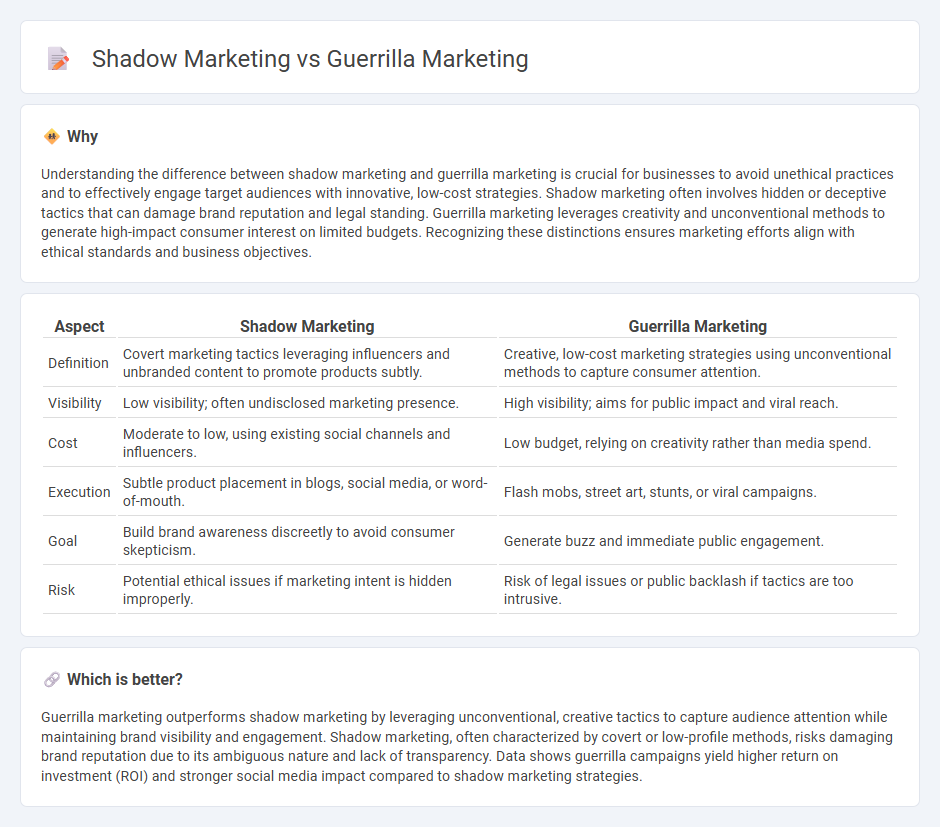
Shadow marketing operates covertly by leveraging indirect promotion tactics that influence consumer behavior without overt advertising, often utilizing digital platforms and stealth strategies. Guerrilla marketing employs unconventional, highly creative, and low-cost approaches designed to capture audience attention through surprise or memorable experiences in public spaces. Discover how these innovative marketing styles redefine brand engagement and maximize impact.
Why it is important
Understanding the difference between shadow marketing and guerrilla marketing is crucial for businesses to avoid unethical practices and to effectively engage target audiences with innovative, low-cost strategies. Shadow marketing often involves hidden or deceptive tactics that can damage brand reputation and legal standing. Guerrilla marketing leverages creativity and unconventional methods to generate high-impact consumer interest on limited budgets. Recognizing these distinctions ensures marketing efforts align with ethical standards and business objectives.
Comparison Table
| Aspect | Shadow Marketing | Guerrilla Marketing |
|---|---|---|
| Definition | Covert marketing tactics leveraging influencers and unbranded content to promote products subtly. | Creative, low-cost marketing strategies using unconventional methods to capture consumer attention. |
| Visibility | Low visibility; often undisclosed marketing presence. | High visibility; aims for public impact and viral reach. |
| Cost | Moderate to low, using existing social channels and influencers. | Low budget, relying on creativity rather than media spend. |
| Execution | Subtle product placement in blogs, social media, or word-of-mouth. | Flash mobs, street art, stunts, or viral campaigns. |
| Goal | Build brand awareness discreetly to avoid consumer skepticism. | Generate buzz and immediate public engagement. |
| Risk | Potential ethical issues if marketing intent is hidden improperly. | Risk of legal issues or public backlash if tactics are too intrusive. |
Which is better?
Guerrilla marketing outperforms shadow marketing by leveraging unconventional, creative tactics to capture audience attention while maintaining brand visibility and engagement. Shadow marketing, often characterized by covert or low-profile methods, risks damaging brand reputation due to its ambiguous nature and lack of transparency. Data shows guerrilla campaigns yield higher return on investment (ROI) and stronger social media impact compared to shadow marketing strategies.
Connection
Shadow marketing and guerrilla marketing both focus on unconventional promotional strategies that target niche audiences through creative and low-cost tactics. Shadow marketing operates under the radar by subtly influencing consumer behavior without overt advertising, while guerrilla marketing uses surprise and memorable experiences to capture attention in public spaces. Both methods leverage psychological engagement and viral potential to enhance brand awareness without relying on traditional mass media campaigns.
Key Terms
**Guerrilla Marketing:**
Guerrilla marketing employs unconventional, low-cost tactics to create maximum brand impact, leveraging creativity and surprise to engage target audiences in public spaces or digital platforms. It capitalizes on viral potential and emotional connections, often using street art, flash mobs, or interactive campaigns to generate buzz and word-of-mouth promotion. Discover how guerrilla marketing can transform your brand's visibility and engagement strategies.
Unconventional tactics
Guerrilla marketing leverages unconventional, low-cost strategies such as street art, flash mobs, and viral stunts to create high-impact brand awareness and engage audiences in unexpected places. Shadow marketing operates subtly behind the scenes, employing covert techniques like influencer seeding, stealth promotions, and secret product placements to build interest without overt advertising. Explore these innovative tactics to enhance your brand's reach and engagement effectively.
Low-budget campaigns
Guerrilla marketing leverages unconventional, creative tactics to generate high impact with minimal budget, often using street art, flash mobs, or viral social media content to engage audiences. Shadow marketing operates more subtly, embedding brand messages within everyday experiences or leveraging influencer partnerships without overt advertising, making it ideal for low-budget campaigns seeking organic reach. Explore effective strategies to maximize your marketing impact while minimizing expenses by discovering more about guerrilla and shadow marketing techniques.
Source and External Links
Guerrilla marketing - Wikipedia - Guerrilla marketing is an advertising strategy using surprise and unconventional interactions to promote products, aiming to create memorable experiences, emotional reactions, and word-of-mouth buzz, often with low cost and high imaginative energy.
What Is Guerrilla Marketing? 4 Types and Examples to Delight ... - Guerrilla marketing exploits unconventional and creative tactics in public spaces to surprise and engage customers, fostering brand awareness mainly through social media and word of mouth while targeting digital platforms where consumers spend much time.
Guerrilla Marketing: understand what it is and how to do it - Salesforce - Guerrilla marketing achieves high impact with low cost by creatively attracting public attention unexpectedly, enhancing customer interaction, expanding brand reach through viral potential, and generating spontaneous media coverage.
 dowidth.com
dowidth.com